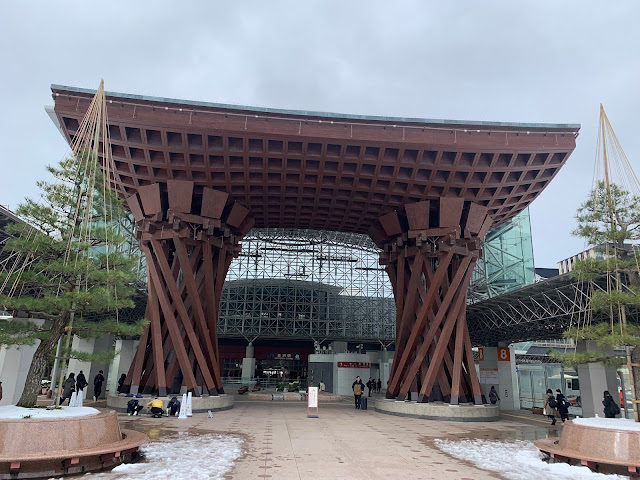Winter Japan Holiday - 2D1N at Kanazawa
After 4 hours of train ride from
Takayama, we reached our next destination - Kanazawa, the capital of Ishikawa
Prefecture.
Once we exited the station, we were greeted by the wooden Tsuzumimon Gate outside the east exit. the gate is modeled after traditional Japanese drums called ‘Tsuzumi’. The gate’s unique style has become a contemporary symbol of Kanazawa.
We checked into the Hotel Nikko
Kanazawa, and it is about a less 5-minute walk away from the train station and bus
terminal. We only spent one night at Kanazawa due to the expiration of our JR
pass which forced us to end our trip early and to head back to Nagoya. To me,
Hotel Nikko Kanazawa has an excellent location as it is literally across the
street from the train station.
As compared to the other hotels we had stayed in during our trip, the room was kinda smaller, but had all the necessities that we needed. I would not hesitate to go back again, as we didn’t manage to do everything in Kanazawa.
Prior to our trip, Baby had made a reservation for our dinner at a restaurant named Tsubajin at 7.30pm on the first day of our arrival in Kanazawa. We took the bus from Kanazawa bus terminal to our dinner venue after we had checked in to our hotel room. The bus journey took us around 15-20mins and when we arrived the place, the manager and a waitress were already waiting for us at the entrance. We were ushered into a spacious private room, which allowed us to have a more intimate and personalized dining experience.
Tsubajin is located across the Sai River and is near to the Nishi Chaya District. The restaurant is also one of the oldest ryotei restaurants in Japan. The dishes are simply exquisite and are of the highest quality. The restaurant is a must visit to experience Kanazawa's history and local cuisine! The interior is elegantly decorated with traditional Japanese elements.
Tsubajin is a Kaiseki restaurant that offers each guest the opportunity to experience a traditional Japanese Kaiseki dining style and to enjoy the delicacies of Kaga cuisine.
We ordered a 10 course Japanese menu, and we were thoroughly impressed! We enjoyed scrumptious food in a unique atmosphere, and we loved the art of Japanese cooking.
Some of the must-try menu items at Tsubajin include the fresh Sashimi Platter, and the local beef.
The waitress made her own matcha tea for us after our desserts and it was this final touch that summarised the Japanese spirit of otomenashi and culinary perfection.
In terms of reservations, this place is always busy but Baby still managed to book it for us via a reservation service called TableCheck, which is similar to our own Chope in Singapore. Tsubajin is a culinary gem that should not be missed. This was the quintessential experience to discover the true essence of Japanese cuisine at this exceptional restaurant. This dinner came with a pricey price tag at ¥57200 for 2 people but the experience and food quality made up for it. We had a wonderful experience, and it was truly the best food experience we had in Japan!
We took the bus back to Kanazawa Bus Terminal, and we walked to the nearest Starbucks to get ourselves a cup of Matcha Latte to beat the cold!
Our room stay was inclusive of breakfast, and we headed down to the café to enjoy a sumptuous breakfast buffet.
We took the bus to the famous Higashi Chaya District. It was quite an interesting experience taking a bus from Kanazawa by boarding from the back-door to take the ticket-fare, and then alighting from the front door by paying the exact amount via cash.
About 99% of all Japanese gold leaf is made in Kanazawa, and this city is brimming with gold - including treats sprinkled with gold powder, dishes covered in sheets of gold leaf, and loads of gold-infused handicrafts!
My recommended gourmet spot is HAKUICHI’s Higashiyama outlet, located in front of the main street at Higashi Chaya’s entrance. They specialize in gold leaf handicrafts, make-up/skincare and sweets/pastries.
The highlight item at HAKUICHI is their ‘Gold Leaf Sparkling Soft-serve Ice Cream’. This photogenic treat, which lavishly incorporates a sheet of gold leaf, was a hit the moment it went on the market.
Utasu Jinja Shrine is a quiet shrine in the back of Higashi Chaya. I found it by chance when we were walking along the district. We actually saw two ninja mannequins, though the Internet said there are 3 at the shrine.
After that we went to the famous Omicho Market for lunch. If you like Sushi, don't miss out on eating at ‘Mori Mori Sushi’. They are a conveyor-belt styled Sushi restaurant that specializes in made to order Sushi, and you place your orders on the touch screen in front of you.
Our next stop had us on an another bus ride, and this time it was to the Oyama-jinja Shrine, which had a three-storied shinmon gate. The gate serves as a symbol of Kanazawa’s vibrancy and importance. The uniqueness of the gate is that the design blends Japanese and Chinese architectural styles with Western touches such as stained glass.
We walked down to Nagamachi (長町), which used to be a Samurai District. It's located pretty near to Kanazawa Castle Ruins, and this is the location where samurai and their families used to reside. This area preserves a historic atmosphere till date!
After that, we took the bus back to the bus terminal and walked back to our hotel to pick up our luggage and walked back to the train station bound for Nagoya!
We spent the time waiting to board the train to check out the souvenir shops located in the train station. We bought some omiyage for our friends and families back home. We also picked up our dinner 'Eki Bento' for consumption during our train ride!




































































Comments